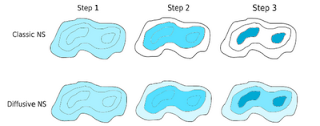Sunday, August 1, 2010
Bus Resistance of a Code or Program
Last year I was on a training for a operating computations on grid at Cornell. Our instructor from Texas threw a Joke: "Do you know the bus resistance of your code?"
Everyone was surprised to hear the question. The Joke is interesting because it indicates one thing and tells you something else. While some people were thinking of how the string of 1's and 0's that travel through the computer data bus might come across such bus resistance, he explained in a funny way.
Here we go:
Imagine one fine friday evening you are grabbing a beer and walking down the road, and you are hit by a bus. What happens to your code? The next day the project manager decides to give your code to your colleague to continue the project. If your code is not properly commented, he will be completely lost in there.
So, the bus resistance is given by the amount of comments in a code and the readability of your code by someone else.
Let us wish that this happens to no one. However, for the continuity of the project in your lab, your code must have very high bus resistance value.
The moral is: comment your code as much as you can.
Cheers!
Are your codes bus resistant?
Wednesday, July 28, 2010
Congratulations to recent Nepali Physics PhD graduates
Wishing all the best to the recent Physics PhD graduates.
Dr. Hikmat BC
New Mexico State University
Dr. Shyam Badu
University at Albany
Dr. Madhav Neupane
Boston College
Dr. Pashupati Dhakal
Dr. Hikmat BC
New Mexico State University
Dr. Shyam Badu
University at Albany
Dr. Madhav Neupane
Boston College
Dr. Pashupati Dhakal
Boston College
Dr. Mukti Aryal
UT Dallas
Tuesday, July 20, 2010
Collective Behavior in Animals
Feel like yawning? Look around, someone near you might also be yawning!
The so called collective behavior such as yawning might be an urban myth but a recent studies have attempted to model such collective behavior. The modal system they considered consists of an example of collective behavior of cows. Such theories have not been tested it in the real cows, however one should not be surprised to see such studies to be verified in near future.
In a recent work, published in arxiv, Sun et. al. study the collective behavior of animals such as cows. Animals are coupled oscillators. They simply model the cow as coupled oscillator. By considering the discrete states of such animals and by considering such couplings, they study the collective decision bearing of such system.
Specifically, they consider three states of cows: standing, sitting and grazing; say "1", "2" and "3" just for sake of easy symbolization. By coupling the states, they assume that behavior of one is going affect the behavior of nearby ones. So, there is more tendency of uniform state such as 1,1,1,1,1 than 1,2,3,2,1 or 1,2,1,2,3. However, for larger cow population there can be some nice oscillatory behavior between the stable states.
The paper is interesting! Have a look.
Ref:
http://arxiv.org/abs/1005.1381
http://www.technologyreview.
Acknowledgements are due to the first author for suggests in the draft version of the post and allowing to use the figures.
On the lighter side:
One can see the influence of "spherical cow" on the coupling diagrams. See Jackson, J.D. Third Edition Ch3 problem#15.
The so called collective behavior such as yawning might be an urban myth but a recent studies have attempted to model such collective behavior. The modal system they considered consists of an example of collective behavior of cows. Such theories have not been tested it in the real cows, however one should not be surprised to see such studies to be verified in near future.
In a recent work, published in arxiv, Sun et. al. study the collective behavior of animals such as cows. Animals are coupled oscillators. They simply model the cow as coupled oscillator. By considering the discrete states of such animals and by considering such couplings, they study the collective decision bearing of such system.
Specifically, they consider three states of cows: standing, sitting and grazing; say "1", "2" and "3" just for sake of easy symbolization. By coupling the states, they assume that behavior of one is going affect the behavior of nearby ones. So, there is more tendency of uniform state such as 1,1,1,1,1 than 1,2,3,2,1 or 1,2,1,2,3. However, for larger cow population there can be some nice oscillatory behavior between the stable states.
The paper is interesting! Have a look.
Ref:
http://arxiv.org/abs/1005.1381
http://www.technologyreview.
Acknowledgements are due to the first author for suggests in the draft version of the post and allowing to use the figures.
Fig: Coupled cows.
On the lighter side:
One can see the influence of "spherical cow" on the coupling diagrams. See Jackson, J.D. Third Edition Ch3 problem#15.
Friday, July 2, 2010
Heading for MaxEnt 2010, Chamonix France
I will be visiting France for a week to attend the MaxEnt 2010 Conference.
There, I will be presenting my work on "Entropy Based Search Algorithm for Experimental Design".
http://maxent2010.inrialpes.fr/program/complete-program/#6.1
I have uploaded some pictures in Facebook. The link is
http://www.facebook.com/
I have uploaded some pictures in Facebook. The link is
http://www.facebook.com/
Friday, June 18, 2010
Diffusive Nested Sampling: Brewer et. al.
Brendon et. al. has a newer version of nested sampling algorithm, they call it Diffusive Nested Sampling (DNS). As the name indicates, it principally differs from the "classic" nested sampling in presenting the hard constraint. It relaxes the hard evolving constraint and lets the samples to explore the mixture distribution of nested probability distributions, each successive distribution occupying e^-1 times the enclosed prior mass of the previously seen distributions. The mixture distribution is weighted at will (a hack :P) which is a clever trick of exploration. This reinforces the idea of "no peaks left behind" for multimodal problems.
On a test problem they claim that DNS "can achieve four times the accuracy of classic Nested Sampling, for the same computational effort; equivalent to a factor of 16 speedup".
PS:
What can grow out of side talks in a conference?
If you know the power of scrapping in the napkin paper, you would not be surprised.
The paper is available in arxiv:
http://arxiv.org/abs/0912.2380
The code is available at: http://lindor.physics.ucsb.edu/DNest/; comes with handy instructions.
---
Thanks are due to Dr. Brewer for indicating typos in the draft and suggestions + allowing to use the figures.
The original nested sampling code is available in the book by sivia and skilling: Data Analysis: A Bayesian Tutorial


Edit: Sep 5, 2013
An illustrative animation of Diffusive Nested Sampling (www.github.com/eggplantbren/DNest3) sampling a multimodal posterior distribution. The size of the yellow circle indicates the importance weight. The method can travel between the modes because the target distribution includes the (uniform) prior as a mixture component.
On a test problem they claim that DNS "can achieve four times the accuracy of classic Nested Sampling, for the same computational effort; equivalent to a factor of 16 speedup".
I have not played with it yet. However, it seems worth trying. Just a note to myself.
PS:
What can grow out of side talks in a conference?
If you know the power of scrapping in the napkin paper, you would not be surprised.
The paper is available in arxiv:
http://arxiv.org/abs/0912.2380
The code is available at: http://lindor.physics.ucsb.edu/DNest/; comes with handy instructions.
---
Thanks are due to Dr. Brewer for indicating typos in the draft and suggestions + allowing to use the figures.
The original nested sampling code is available in the book by sivia and skilling: Data Analysis: A Bayesian Tutorial






